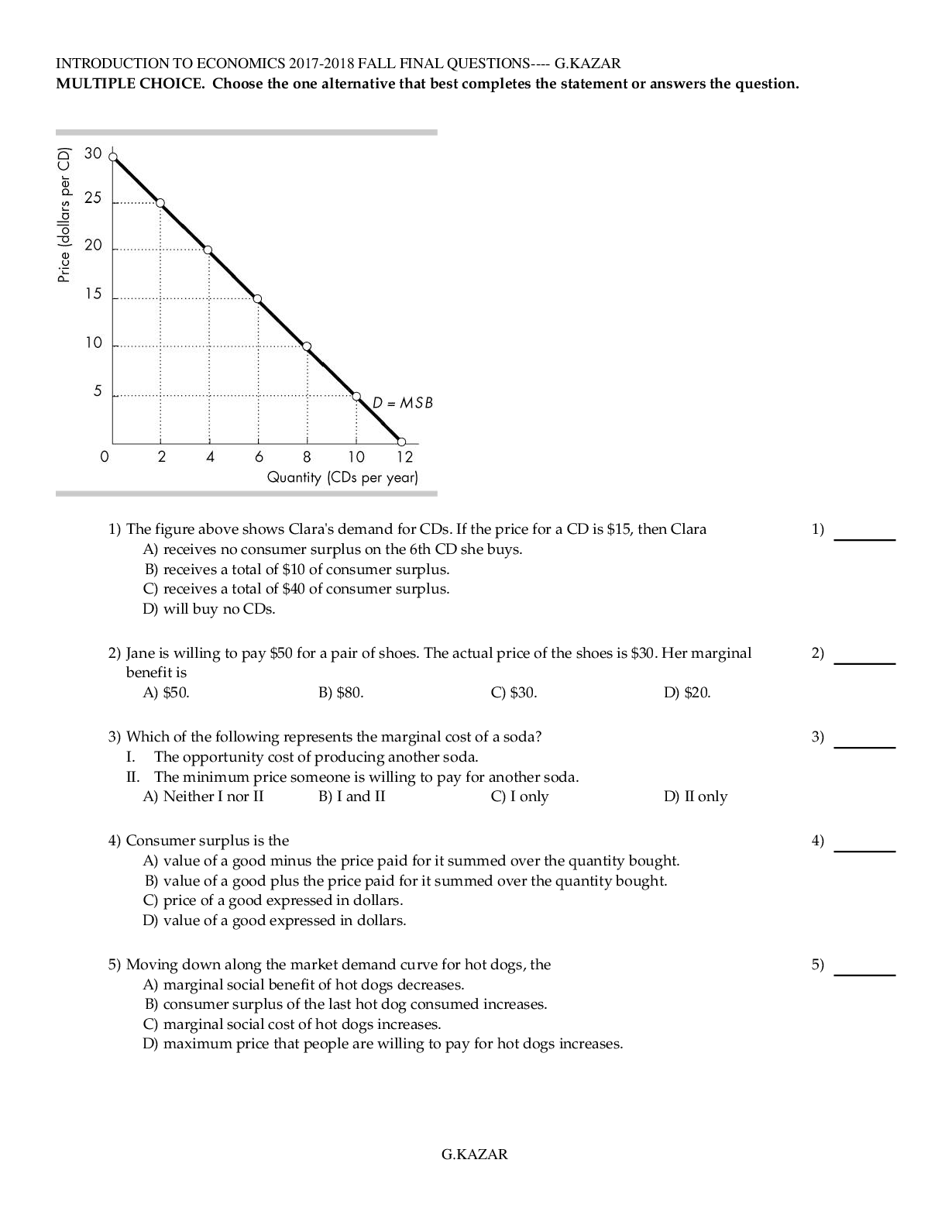Engineering > QUESTIONS & ANSWERS > Introduction to Analytics Modeling. 5/1/2020 Midterm Quiz 2. All The Answers Provided. (All)
Introduction to Analytics Modeling. 5/1/2020 Midterm Quiz 2. All The Answers Provided.
Document Content and Description Below
5/1/2020 Midterm Quiz 2 - GT Students and Verified MM Learners | Midterm Quiz 2 | ISYE6501x Courseware | edX Introduction to Analytics Modeling Help khoi32 Course Midterm Quiz 2 - Spring 2... 020 Midterm Quiz 2 Midterm Quiz 2 - GT Students and VeriÕed MM Learners Midterm Quiz 2 - GT Students and VeriÕed MM Learners 90 Minute Time Limit Instructions Work alone. Do not collaborate with or copy from anyone else. You may use any of the following resources: One sheet (both sides) of handwritten (not photocopied or scanned) notes If any question seems ambiguous, use the most reasonable interpretation (i.e. don't be like Calvin): Good Luck! This the beginning of Midterm Quiz 2. Please make sure that you all your answers before the time runs out. Once you an answer to a question, you cannot change it. There is no overall button. Information for Question 1 There are Õve questions labeled "Question 1." Answer all Õve questions. For each of the following Õve questions, select the probability distribution that could best be used to model the described scenario. Each distribution might be used, zero, one, or more than one time in the Õve questions. Question 1 1.4/1.4 points (graded) Number of days in a year where the temperature is more than 3 degrees higher than forecast Binomial You have used 1 of 1 attempt Question 1 1.4/1.4 points (graded) Number of phone calls made by a telemarketer until one is answered Geometric You have used 1 of 1 attempt Question 1 1.4/1.4 points (graded) Time from the beginning of Fall until the Õrst snowÖake is seen Weibull You have used 1 of 1 attempt Question 1 1.4/1.4 points (graded) Time from when a house is put on the market until the Õrst oàer is received Weibull You have used 1 of 1 attempt Question 1 5/1/2020 Midterm Quiz 2 - GT Students and Verified MM Learners | Midterm Quiz 2 | ISYE6501x Courseware | edX Answers are displayed within the problem 1.4/1.4 points (graded) Time from when a generator is turned on until it fails Weibull You have used 1 of 1 attempt Questions 2a, 2b 5.0/10.0 points (graded) Five classiÕcation models were built for predicting whether a neighborhood will soon see a large rise in home prices, based on public elementary school ratings and other factors. The training data set was missing the school rating variable for every new school (3% of the data points). Because ratings are unavailable for newly-opened schools, it is believed that locations that have recently experienced high population growth are more likely to have missing school rating data. Model 1 used imputation, Õlling in the missing data with the average school rating from the rest of the data. Model 2 used imputation, building a regression model to Õll in the missing school rating data based on other variables. Model 3 used imputation, Õrst building a classiÕcation model to estimate (based on other variables) whether a new school is likely to have been built as a result of recent population growth (or whether it has been built for another purpose, e.g. to replace a very old school), and then using that classiÕcation to select one of two regression models to Õll in an estimate of the school rating; there are two diàerent regression models (based on other variables), one for neighborhoods with new schools built due to population growth, and one for neighborhoods with new schools built for other reasons. Model 4 used a binary variable to identify locations with missing information. Model 5 used a categorical variable: Õrst, a classiÕcation model was used to estimate whether a new school is likely to have been built as a result of recent population growth; and then each neighborhood was categorized as "data available", "missing, population growth", or "missing, other reason". a. If school ratings cannot be reasonably well-predicted from the other factors, and new schools built due to recent population growth cannot be reasonably well-classiÕed using the other factors, which model would you recommend? b. In which of the following situations would you recommend using Model 5? [All predictions and classiÕcations below are using the other factors.] You have used 1 of 1 attempt Information for Question 3 In a diet problem (like we saw in the lessons and homework), let x be the amount of food i in the solution (x >= 0), and let M be the maximum amount that can be eaten of any food. Suppose we added new variables y that are binary (i.e., they must be either 0 or 1): if food i is eaten in the solution, then it is part of the solution (y = 1); otherwise y = 0. There are Õve questions labeled "Question 3." Answer all Õve questions. For each of the following Õve questions, select the mathematical constraint that best corresponds to the English sentence. Each constraint might be used, zero, one, or more than one time in the Õve questions. Question 3 1.4/1.4 points (graded) Select the mathematical constraint that corresponds to the following English sentence: Ratings can be well-predicted, and reasons for building schools can be well-classiÕed. Ratings can be well-predicted, and reasons for building schools cannot be well-classiÕed. Ratings cannot be well-predicted, and reasons for building schools can be well-classiÕed. Ratings cannot be well-predicted, and reasons for building schools cannot be well-classiÕed. 2020 Midterm Quiz 2 - GT Students and Verified MM Learners | Midterm Quiz 2 | ISYE6501x Courseware | edX Either cheese sauce or peanut butter (or both) must be eaten with broccoli. You have used 1 of 1 attempt Question 3 1.4/1.4 points (graded) Select the mathematical constraint that corresponds to the following English sentence: Exactly one of peanut butter and cheese sauce must be eaten. You have used 1 of 1 attempt Question 3 1.4/1.4 points (graded) Select the mathematical constraint that corresponds to the following English sentence: Broccoli, cheese sauce, and peanut butter all can't be eaten together. You have used 1 of 1 attempt ????????????? + ??ℎ????????? = 0 ????????????? = 1 - ??ℎ????????? ????????? ≤ ??ℎ????????? + ????????????? ????????? + ??ℎ????????? + ????????????? ≤ 2 ??ℎ????????? ≤ ???ℎ????????? ??ℎ????????? = 1 ????????? ≤ ?????????????? ????????? ≥ ?????????????? ????????????? + ??ℎ????????? = 0 ????????????? = 1 - ??ℎ????????? ????????? ≤ ??ℎ????????? + ????????????? ????????? + ??ℎ????????? + ????????????? ≤ 2 ??ℎ????????? ≤ ???ℎ????????? ??ℎ????????? = 1 ????????? ≤ ?????????????? ????????? ≥ ?????????????? ????????????? + ??ℎ????????? = 0 ????????????? = 1 - ??ℎ????????? ????????? ≤ ??ℎ????????? + ????????????? ????????? + ??ℎ????????? + ????????????? ≤ 2 ??ℎ????????? ≤ ???ℎ????????? ??ℎ????????? = 1 ????????? ≤ ?????????????? ????????? ≥ ?????????????? 5/1/2020 Midterm Quiz 2 - GT Students and Verified MM Learners | Midterm Quiz 2 | ISYE6501x Courseware | edX Question 3 1.4/1.4 points (graded) Select the mathematical constraint that corresponds to the following English sentence: No more than two of broccoli, cheese sauce, and peanut butter may be eaten. You have used 1 of 1 attempt Question 3 1.4/1.4 points (graded) Select the mathematical constraint that corresponds to the following English sentence: Either peanut butter or cheese sauce, but not both, must be eaten. You have used 1 of 1 attempt Question 4a 5.0/5.0 points (graded) A hospital emergency department (ED) has created a stochastic discrete-event simulation model of the ED, including patient arrivals, resource usage (rooms, doctors, etc.), and treatment duration. EDs are not Õrst-come-Õrst-served; a patient who arrives with a more-serious condition will be treated Õrst, ahead of even long-waiting patients with less-serious conditions. When a patient comes in, the ED will run the simulation to quickly give the patient an estimate of the expected wait time before being treated. How many times does the ED need to run the simulation for each new patient (i.e., how many replications are needed)? You have used 1 of 1 attempt Information for Question 4b ????????????? + ??ℎ????????? = 0 ????????????? = 1 - ??ℎ????????? ????????? ≤ ??ℎ????????? + ????????????? ????????? + ??ℎ????????? + ????????????? ≤ 2 ??ℎ????????? ≤ ???ℎ????????? ??ℎ????????? = 1 ????????? ≤ ?????????????? ????????? ≥ ?????????????? ????????????? + ??ℎ????????? = 0 ????????????? = 1 - ??ℎ????????? ????????? ≤ ??ℎ????????? + ????????????? ????????? + ??ℎ????????? + ????????????? ≤ 2 ??ℎ????????? ≤ ???ℎ????????? ??ℎ????????? = 1 ????????? ≤ ?????????????? ????????? ≥ ?????????????? Once, because the outcome will be the same each time Many times, because of the variability and randomness Once, because each patient is unique 5/1/2020 Midterm Quiz 2 - GT Students and Verified MM Learners | Midterm Quiz 2 | ISYE6501x Courseware | edX The Õgure above shows the average of the Õrst x simulated wait times, as new replications ("runs") are run and added into the overall average. It is not showing the wait time just for each replication. For example, after x=101 replications, the wait time of the 101st replication is not necessarily 72, but the average of those 101 replications is about 72. Question 4b 5.0/5.0 points (graded) If the goal is to report the expected wait time to within +/- 2 minutes, what can you conclude from the Õgure above? Select all of the answers that are correct. You have used 1 of 1 attempt Question 4c 6.0/6.0 points (graded) Suppose it is discovered that simulated wait times are 25% higher than actual wait times, on average. What would you recommend that they do? You have used 1 of 1 attempt Information for Question 5 For each of the optimization problems below, select its most precise classiÕcation. In each model, x are the variables, all other letters (a,b,c) refer to known data, and the values of c are all positive. There are seven questions labeled "Question 5". Answer all seven questions. Each classiÕcation might be used, zero, one, or more than one time in the seven questions. Question 5 1.0/1.0 point (graded) Minimize subject to for all all Integer program You have used 1 of 1 attempt The simulation could have been stopped after 400 runs (replications). The simulation could even have been stopped after 300 runs (replications). The simulated wait time was 50 or less just once out of all the runs (replications). The expected wait time of simulated runs (replications) is likely to be between 65 and 75. There is very little variability in the simulated wait time of the runs (replications). Scale down all estimates by a factor of 1/1.25 to get the average simulation estimates to match the average actual wait times. Investigate to see what's wrong with the simulation, because it's a poor match to reality. Use the 25%-higher estimates, because that's what the simulation output is. 5/1/2020 Midterm Quiz 2 - GT Students and Verified MM Learners | Midterm Quiz 2 | ISYE6501x Courseware | edX Answers are displayed within the problem Question 5 1.0/1.0 point (graded) Minimize subject to for all all Linear program You have used 1 of 1 attempt Question 5 1.0/1.0 point (graded) Minimize subject to for all all General non-convex program You have used 1 of 1 attempt Question 5 1.0/1.0 point (graded) Minimize log subject to for all all Linear program You have used 1 of 1 attempt Question 5 1.0/1.0 point (graded) Minimize subject to for all all Convex quadratic program You have used 1 of 1 attempt Question 5 0.0/1.0 point (graded) Minimize sin subject to for all all General non-convex program Answer: General non-convex program You have used 1 of 1 attempt Question 5 1.0/1.0 point (graded) Minimize subject to for all all Convex program You have used 1 of 1 attempt Questions 6a,6b,6c 9.32/12.0 points (graded) 5/1/2020 Midterm Quiz 2 - GT Students and Verified MM Learners | Midterm Quiz 2 | ISYE6501x Courseware | edX Answers are displayed within the problem A medium-sized city is analyzing the size of its judicial system, speciÕcally the number of judges it has available for hearing cases at diàerent times of the year. At busy times (about 10% of the times), the arrival rate is 20 new cases ready for trial per day. At other times, the arrival rate is 10 new cases ready for trial per day. Once an judge is assigned to a case (at any time), it takes an average of 0.5 days to complete. [NOTE: This is a very simpliÕed version of the judicial system. If you have deeper knowledge of how the judicial system works, please do not use it for this question; you would end up making the question more complex than it is designed to be.] a. The Õrst model the city tries is a queuing model with 3 judges always available. What would you expect the queuing model to show? b. The second model the city tries is a queuing model with 15 judges available during busy times and 7 judges availableduring non-busy times. What would you expect the queuing model to show? c. The third model the city tries is a Markov chain, where each state is the number of cases waiitng (e.g., 0 cases waiting, 1 case waiting, etc.). When there are at least 20 total cases waiting, the city will refer waiting caess to arbitrators who try to get the cases settled without a trial (arbitration also takes about 0.5 days per case). Once the arbitrators start hearing cases, the arbitrators continue to be assigned cases until no more cases are waiting. Select all of the following statements about the model and the memoryless property (previous states don't aàect the probability of moving from one state to another) that are true. You have used 1 of 1 attempt Questions 7a,7b 10.0/10.0 points (graded) A retailer is testing two diàerent customer retention approaches. The retailer is using A/B testing: For each customer, the retailer randomly selects one approach or the other to use. The results after 2000 trials are shown below. Trials Customer loss rate 95% conÕdence interval Option A 1036 4.8% 3.6%-6.2% Option B 964 10.4% 8.5%-12.3% Note: Lower customer loss rates are better. a. What should the retailer do? Later, the retailer developed 7 new options, so they used a multi-armed bandit approach where each option is chosen with probability proportional to its likelihood of being the best. The results after 2000 total trials are shown below. Customer loss rate 15.9% 95% conÕdence interval 9.5%-22.2% Option #1 Wait times are low at both busy and non-busy times. Wait times are low at busy times and high at non-busy times. Wait times are low at non-busy times and high at busy times. Wait times are high at both busy and non-busy times. Wait times are low at both busy and non-busy times. Wait times are low at busy times and high at non-busy times. Wait times are low at non-busy times and high at busy times. Wait times are high at both busy and non-busy times. The process is memoryless. If the arrivals follow the Poisson distribution and the checkout times follow the Exponential distribution, then the process is memoryless. We can't say the process is memoryless because the model is not well-deÕned. For example, the transition probabilities from the state "3 people are waiting" depend on how many lines are currently open, which isn't captured as part of the states of the Markov chain. Switch to exploitation (utilize Option A only; A is clearly better) Switch to exploitation (utilize Option B only; B is clearly better) More exploration (test both options; it is unclear yet which is better) 5/1/2020 Midterm Quiz 2 - GT Students and Verified MM Learners | Midterm Quiz 2 | ISYE6501x Courseware | edX Note: Lower customer loss rates are better. b. What should the retailer do? You have used 1 of 1 attempt Information for Question 8a For each of the mathematical optimization models, select the variable-selection/regularization method it most-precisely represents (or select "none of the above" if none of the other choices are appropriate). In each model, x is the data, y is the response, a are the coeÞcients, n is the number of data points, m is the number of predictors, and T and are appropriate constants. There are four questions labeled "Question 8a". Answer all four questions. Each of the choices might be used zero, one, or more than one time in the four questions. Question 8a 1.0/1.0 point (graded) Minimize subject to Ridge regression You have used 1 of 1 attempt Question 8a 1.0/1.0 point (graded) Minimize subject to Elastic net You have used 1 of 1 attempt Question 8a 1.0/1.0 point (graded) Minimize None of the above You have used 1 of 1 attempt Question 8a 1.0/1.0 point (graded) Minimize subject to Lasso regression You have used 1 of 1 attempt Move to pure exploitation: use only Option 7 Continue the multi-armed bandit approach using only Options 6 and 7 Continue the multi-armed bandit approach using only Options 5, 6, and 7 Continue the multi-armed bandit approach using all seven options Question 8b 5/1/2020 Midterm Quiz 2 - GT Students and Verified MM Learners | Midterm Quiz 2 | ISYE6501x Courseware | edX Question 8c 6.0/6.0 points (graded) Select all of the following reasons that you might want to use stepwise regression, lasso, etc. to limit the number of factors in a model. You have used 1 of 1 attempt Question 8d 3.0/3.0 points (graded) In the simple linear regression model i. What are the variables from an optimization perspective? 1/4 points (graded) Keyboard Help Rank the following regression and variable-selection/regularization methods from fewest variables selected to most variables selected. All four methods will be used (the bottom contains two equivalent spaces). FEEDBACK Correctly placed 1 item. Misplaced 3 items. Good work! You have completed this drag and drop problem. Final attempt was used, highest score is 1.0 You have used 1 of 1 attempts. Reset Show Answer Because there isn't enough data to avoid overÕtting a model with many factors To Õnd a simpler model To Õnd a more-complex model Lasso regression Elastic net Ridge regression Linear regression ii. What are the variables from a regression perspective? You have used 1 of 1 attempt There are Õve questions labeled "Question 9". Answer all Õve questions. For each question, select the most appropriate model/approach to answer the question/analyze the situation described. Each model/approach might be used zero, one, or more than one time in the Õve questions. Question 9 1.4/1.4 points (graded) Determine the best marketing strategy, given that a competitor will react to your choice in his/her decisions. Game theoretic analysis You have used 1 of 1 attempt Question 8e 7/7 points (graded) Keyboard Help Put the following seven steps in order, from what is done Õrst to what is done last. FEEDBACK Correctly placed 7 items. Good work! You have completed this drag and drop problem. Final attempt was used, highest score is 7.0 You have used 1 of 1 attempts. Reset Show Answer Remove outliers Scale data Impute missing data values Fit lasso regression model on all variables Fit linear regression, regression tree, and random forest models using variables chosen by lasso regression Pick model to use based on performance on a diàerent data set Test model on another diàerent set of data to estimate quality © All Rights Reserved Answers are displayed within the problem 1.4/1.4 points (graded) Does Lasik surgery signiÕcantly improve the median vision of people who get that surgery? Non-parametric test You have used 1 of 1 attempt Question 9 1.4/1.4 points (graded) How many new minivans should a manufacturer plan to make this year, given demand uncertainty? Stochastic optimization You have used 1 of 1 attempt Question 9 1.4/1.4 points (graded) Which month has a signiÕcantly higher median temperature, July or August (or neither)? Non-parametric test You have used 1 of 1 attempt Question 9 0.0/1.4 points (graded) What is the best route for a delivery vehicle to take, given uncertainties in upcoming traÞc? Louvain algorithm Answer: Stochastic optimization You have used 1 of 1 attempt This the end of Midterm Quiz 2. Please make sure that you all your answers before the time runs out. There is no overall button. [Show More]
Last updated: 1 year ago
Preview 1 out of 11 pages
Instant download

Buy this document to get the full access instantly
Instant Download Access after purchase
Add to cartInstant download
Reviews( 0 )
Document information
Connected school, study & course
About the document
Uploaded On
Mar 03, 2021
Number of pages
11
Written in
Additional information
This document has been written for:
Uploaded
Mar 03, 2021
Downloads
0
Views
72







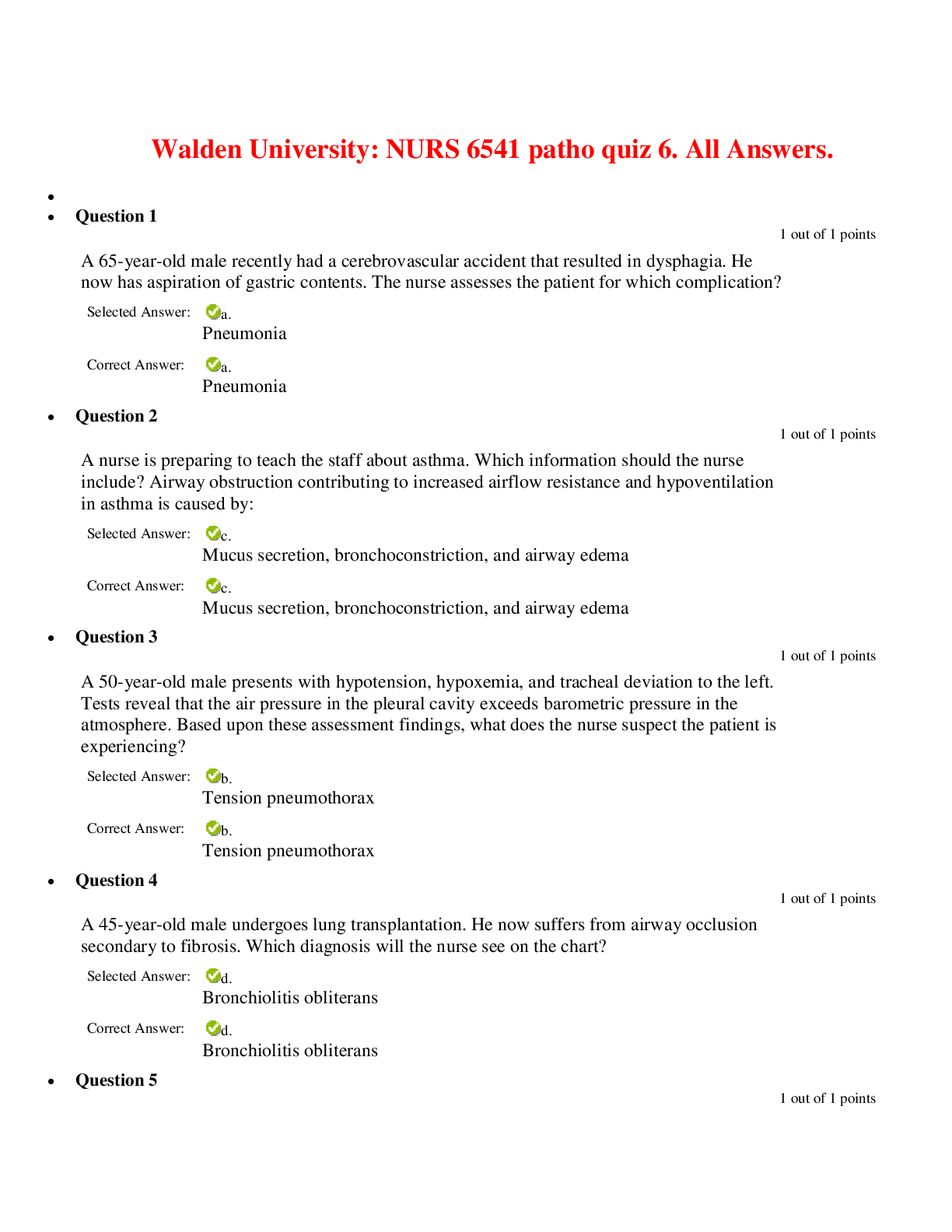





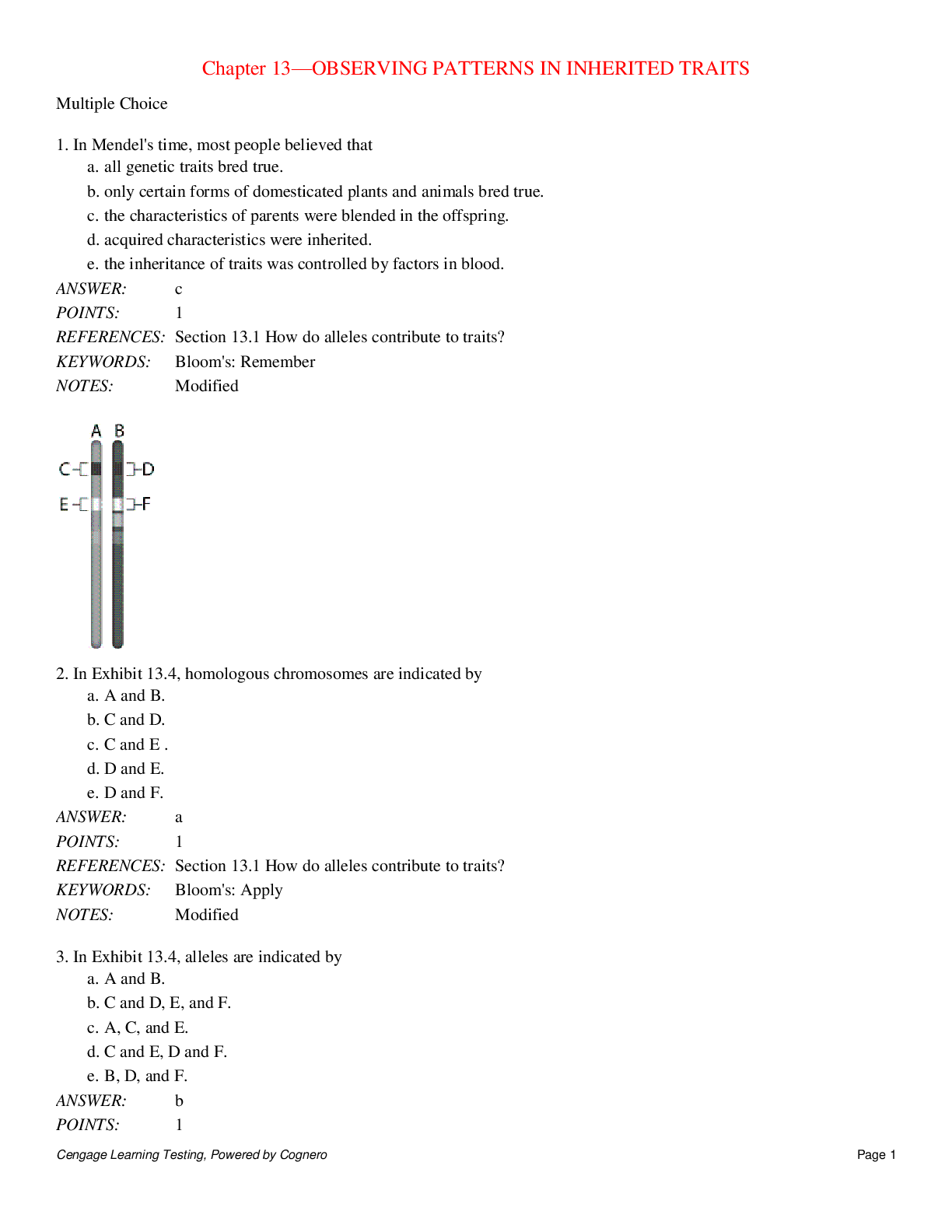
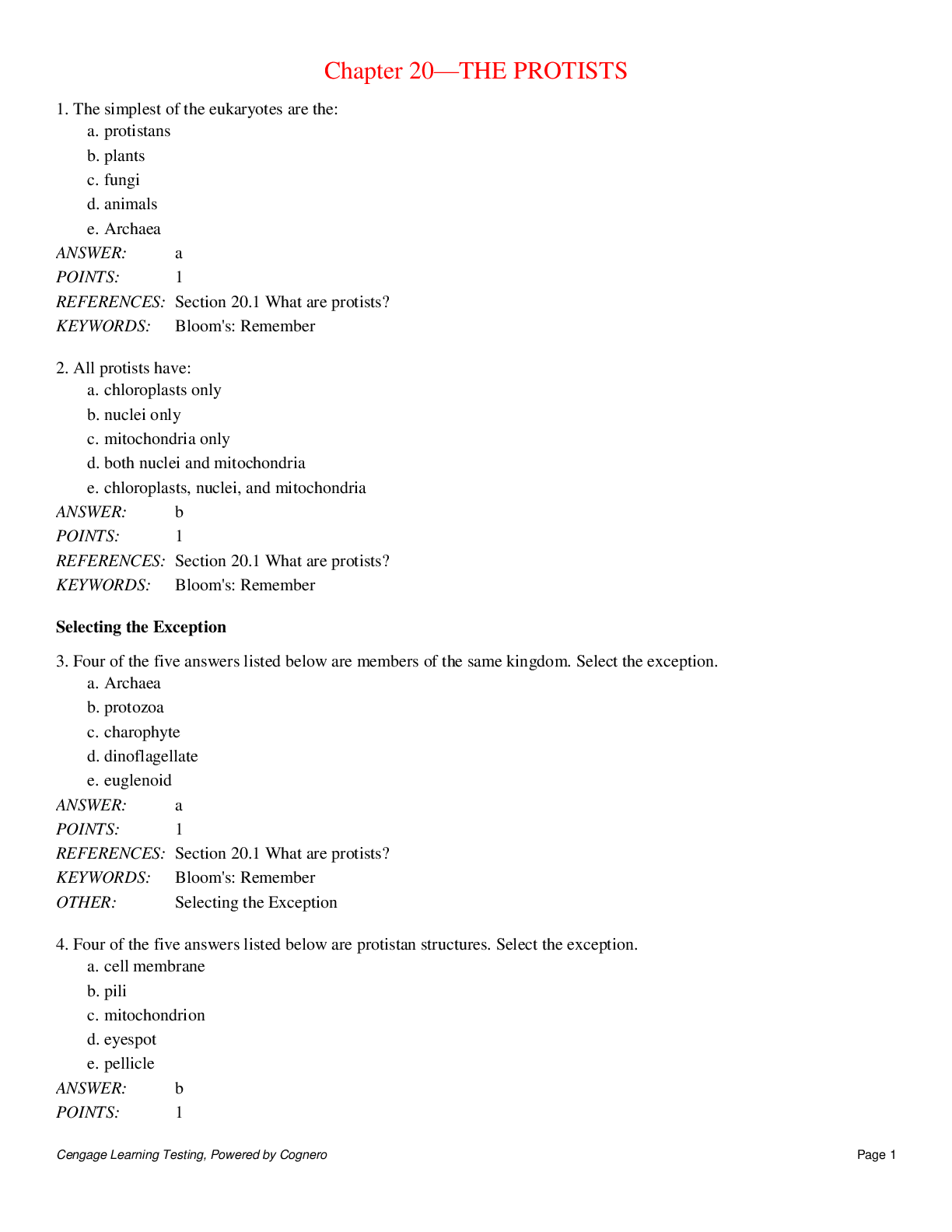
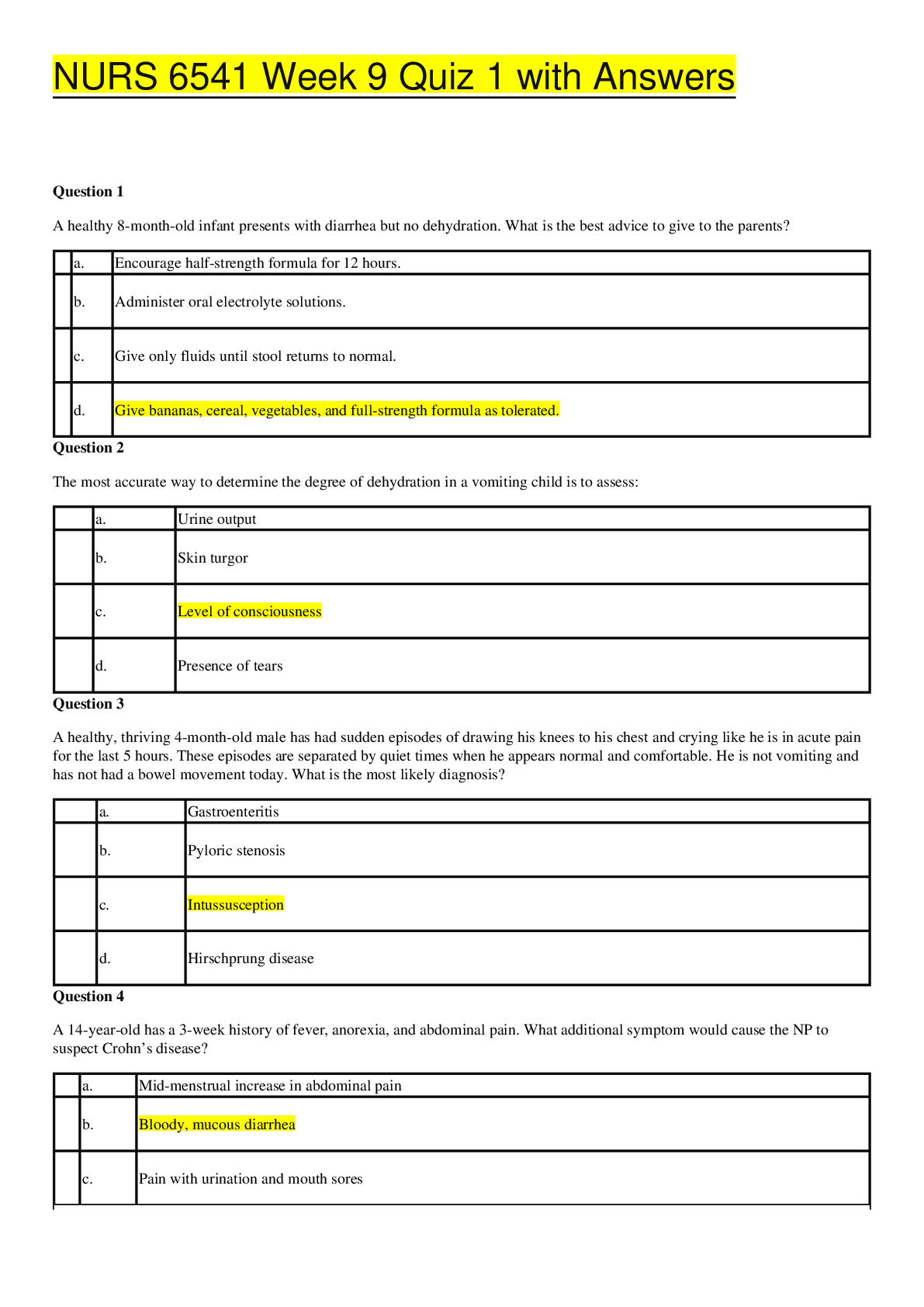
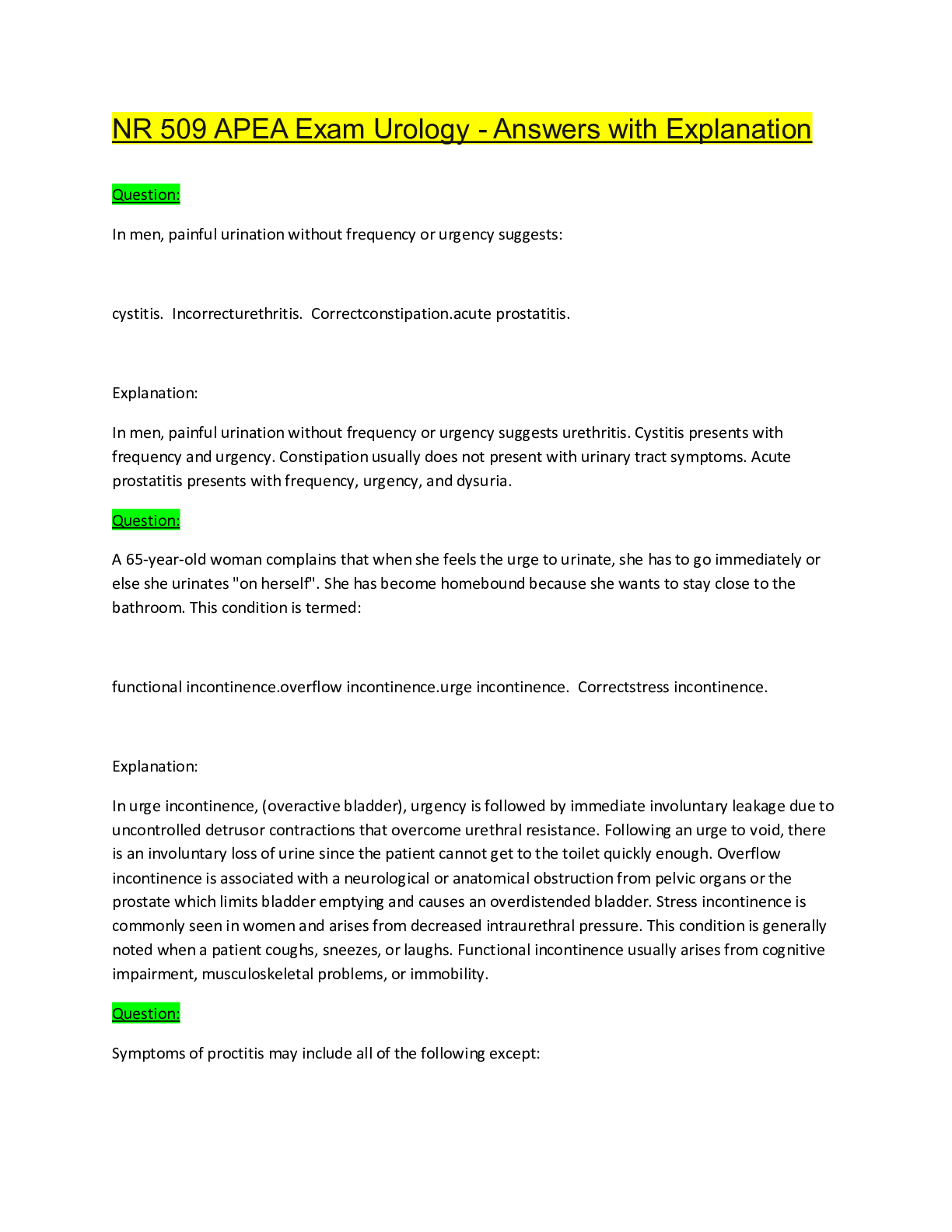
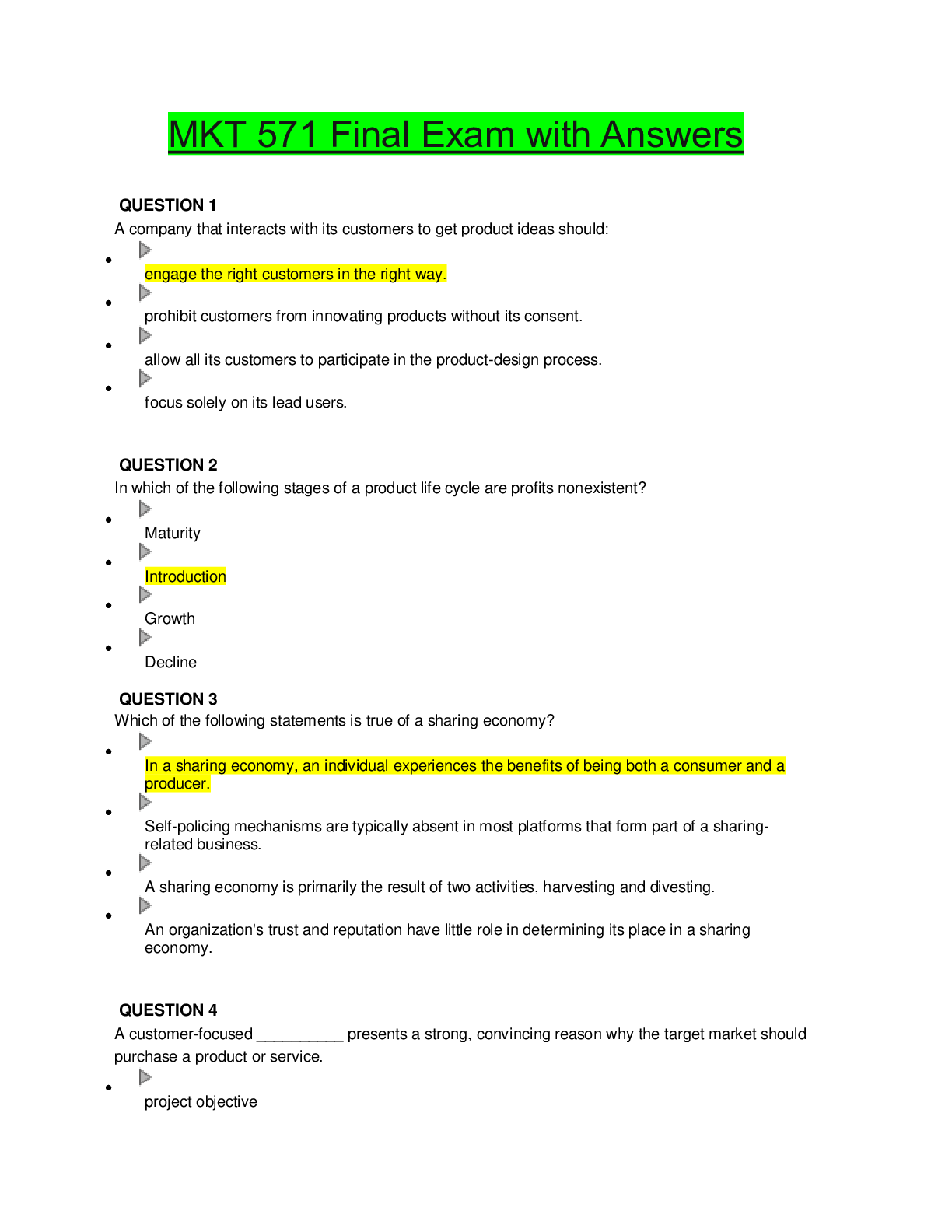

.png)
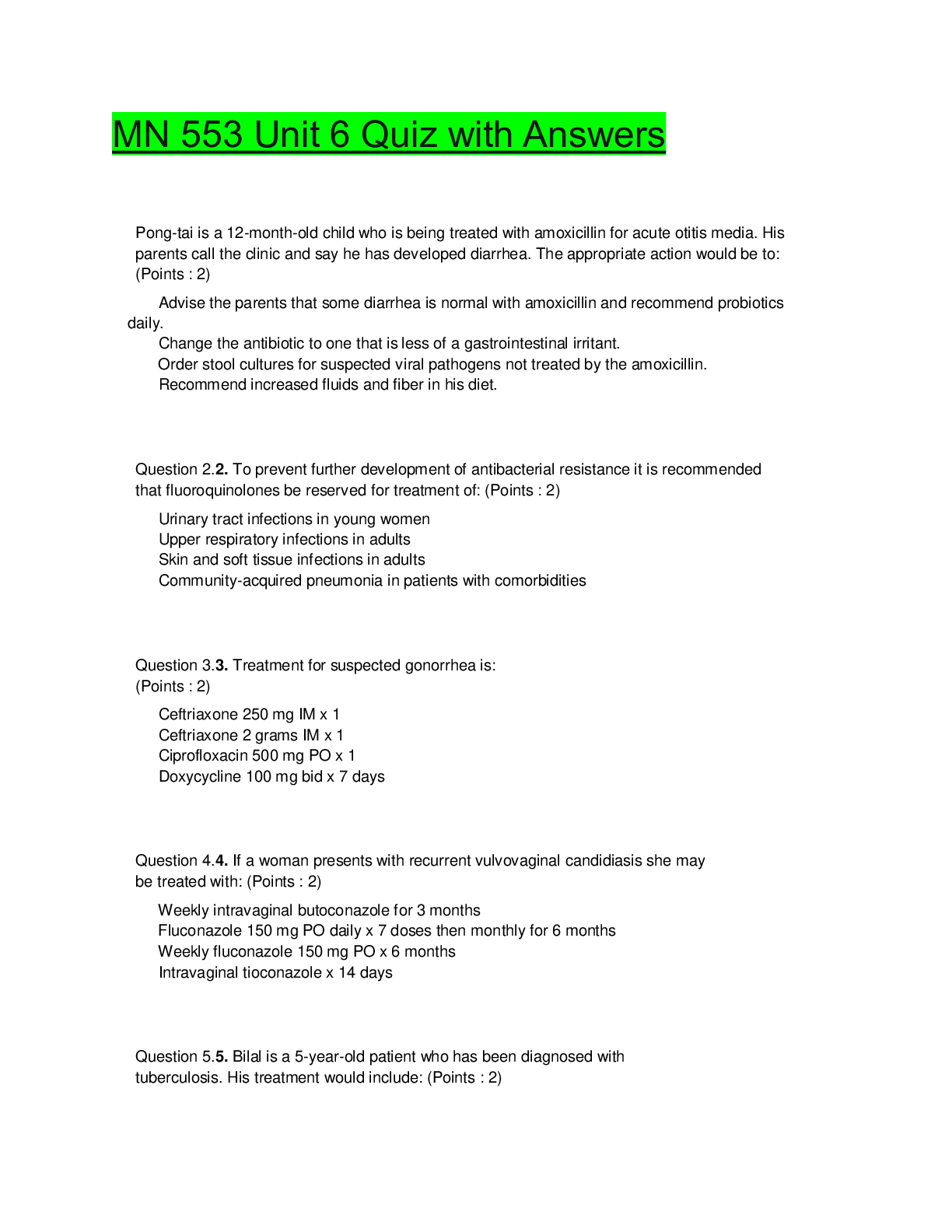
.png)

.png)
